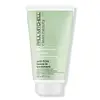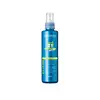What's inside
What's inside
 Key Ingredients
Key Ingredients

 Benefits
Benefits

 Concerns
Concerns

 Ingredients Side-by-side
Ingredients Side-by-side

Water
Skin ConditioningCetearyl Alcohol
EmollientCyclopentasiloxane
EmollientVp/Dmapa Acrylates Copolymer
Polyquaternium-37
Behentrimonium Methosulfate
Propylene Glycol
HumectantVerbascum Densiflorum Flower/Stem Extract
Skin ConditioningHelichrysum Italicum Extract
AntiseborrhoeicCota Tinctoria Flower/Leaf/Stem Extract
Skin ConditioningLinum Usitatissimum Seed Extract
PerfumingSodium Hyaluronate
HumectantHydrolyzed Hyaluronic Acid
HumectantAlmond Oil Glycereth-8 Esters
EmollientPeach Kernel Oil Glycereth-8 Esters
CleansingPanthenol
Skin ConditioningHydrolyzed Vegetable Protein
Skin ConditioningDimethicone
EmollientCaprylyl Glycol
EmollientPPG-20 Methyl Glucose Ether
Skin ConditioningGlycerin
HumectantCetrimonium Chloride
AntimicrobialCitric Acid
BufferingLactic Acid
BufferingTrideceth-8
EmulsifyingDisodium EDTA
Phenoxyethanol
PreservativePotassium Sorbate
PreservativeSodium Gluceptate
Benzalkonium Chloride
AntimicrobialSodium Benzoate
MaskingPhenethyl Alcohol
MaskingParfum
MaskingBenzyl Alcohol
PerfumingWater, Cetearyl Alcohol, Cyclopentasiloxane, Vp/Dmapa Acrylates Copolymer, Polyquaternium-37, Behentrimonium Methosulfate, Propylene Glycol, Verbascum Densiflorum Flower/Stem Extract, Helichrysum Italicum Extract, Cota Tinctoria Flower/Leaf/Stem Extract, Linum Usitatissimum Seed Extract, Sodium Hyaluronate, Hydrolyzed Hyaluronic Acid, Almond Oil Glycereth-8 Esters, Peach Kernel Oil Glycereth-8 Esters, Panthenol, Hydrolyzed Vegetable Protein, Dimethicone, Caprylyl Glycol, PPG-20 Methyl Glucose Ether, Glycerin, Cetrimonium Chloride, Citric Acid, Lactic Acid, Trideceth-8, Disodium EDTA, Phenoxyethanol, Potassium Sorbate, Sodium Gluceptate, Benzalkonium Chloride, Sodium Benzoate, Phenethyl Alcohol, Parfum, Benzyl Alcohol
Water
Skin ConditioningPropylene Glycol
HumectantCetearyl Alcohol
EmollientBehentrimonium Chloride
PreservativeCyclopentasiloxane
EmollientPanthenol
Skin ConditioningHydrolyzed Silk
HumectantChondrus Crispus
MaskingHydrolyzed Keratin
HumectantLinoleamidopropyl Pg-Dimonium Chloride Phosphate
Amodimethicone
Polysilicone-15
UV FilterSilicone Quaternium-22
Cetrimonium Chloride
AntimicrobialButylene Glycol
HumectantIsopropyl Alcohol
SolventPPG-3 Myristyl Ether
EmollientButyl Methoxydibenzoylmethane
UV AbsorberTocopheryl Acetate
AntioxidantXanthan Gum
EmulsifyingCitric Acid
BufferingTrideceth-12
EmulsifyingDisodium EDTA
Lecithin
EmollientCaprylyl Glycol
EmollientDiazolidinyl Urea
PreservativePhenoxyethanol
PreservativeIodopropynyl Butylcarbamate
PreservativePotassium Sorbate
PreservativeParfum
MaskingAmyl Cinnamal
PerfumingBenzyl Alcohol
PerfumingCitronellol
PerfumingCoumarin
PerfumingLimonene
PerfumingHydroxycitronellal
PerfumingLinalool
PerfumingBenzyl Benzoate
AntimicrobialAlpha-Isomethyl Ionone
PerfumingCinnamyl Alcohol
PerfumingWater, Propylene Glycol, Cetearyl Alcohol, Behentrimonium Chloride, Cyclopentasiloxane, Panthenol, Hydrolyzed Silk, Chondrus Crispus, Hydrolyzed Keratin, Linoleamidopropyl Pg-Dimonium Chloride Phosphate, Amodimethicone, Polysilicone-15, Silicone Quaternium-22, Cetrimonium Chloride, Butylene Glycol, Isopropyl Alcohol, PPG-3 Myristyl Ether, Butyl Methoxydibenzoylmethane, Tocopheryl Acetate, Xanthan Gum, Citric Acid, Trideceth-12, Disodium EDTA, Lecithin, Caprylyl Glycol, Diazolidinyl Urea, Phenoxyethanol, Iodopropynyl Butylcarbamate, Potassium Sorbate, Parfum, Amyl Cinnamal, Benzyl Alcohol, Citronellol, Coumarin, Limonene, Hydroxycitronellal, Linalool, Benzyl Benzoate, Alpha-Isomethyl Ionone, Cinnamyl Alcohol
Ingredients Explained
These ingredients are found in both products.
Ingredients higher up in an ingredient list are typically present in a larger amount.
Benzyl Alcohol is most commonly used as a preservative. It also has a subtle, sweet smell. Small amounts of Benzyl Alcohol is not irritating and safe to use in skincare products. Most Benzyl Alcohol is derived from fruits such as apricots.
Benzyl Alcohol has both antibacterial and antioxidant properties. These properties help lengthen the shelf life of products. Benzyl Alcohol is a solvent and helps dissolve other ingredients. It can also improve the texture and spreadability.
Alcohol comes in many different forms. Different types of alcohol will have different effects on skin. This ingredient is an astringent alcohol.
Using high concentrations of these alcohols are drying on the skin. They may strip away your skin's natural oils and even damage your skin barrier. Astringent alcohols may also irritate skin.
Other types of astringent alcohols include:
According to the National Rosacea Society based in the US, you should be mindful of products with these alcohols in the top half of ingredients.
Any type of sanitizing product will have high amounts of alcohol to help kill bacteria and viruses.
Learn more about Benzyl AlcoholCaprylyl Glycol is a humectant and emollient, meaning it attracts and preserves moisture.
It is a common ingredient in many products, especially those designed to hydrate skin. The primary benefits are retaining moisture, skin softening, and promoting a healthy skin barrier.
Though Caprylyl Glycol is an alcohol derived from fatty acids, it is not the kind that can dry out skin.
This ingredient is also used as a preservative to extend the life of products. It has slight antimicrobial properties.
Learn more about Caprylyl GlycolCetearyl alcohol is a mixture of two fatty alcohols: cetyl alcohol and stearyl alcohol. It is mainly used as an emulsifier. Emulsifiers help prevent the separation of oils and products. Due to its composition, it can also be used to thicken a product or help create foam.
Cetearyl alcohol is an emollient. Emollients help soothe and hydrate the skin by trapping moisture.
Studies show Cetearyl alcohol is non-toxic and non-irritating. The FDA allows products labeled "alcohol-free" to have fatty alcohols.
This ingredient is usually derived from plant oils such as palm, vegetable, or coconut oils. There is debate on whether this ingredient will cause acne.
Due to the fatty acid base, this ingredient may not be Malassezia folliculitis safe.
Learn more about Cetearyl AlcoholThis ingredient is a preservative, antimicrobial, and emulsifier. It is often used in cosmetics for its ability to cleanse, condition, and reduce static.
Cetrimonium chloride is a quaternary ammonium salt, meaning it has a water-soluble structure.
Citric Acid is an alpha hydroxy acid (AHA) naturally found in citrus fruits like oranges, lemons, and limes.
Like other AHAs, citric acid can exfoliate skin by breaking down the bonds that hold dead skin cells together. This helps reveal smoother and brighter skin underneath.
However, this exfoliating effect only happens at high concentrations (20%) which can be hard to find in cosmetic products.
Due to this, citric acid is usually included in small amounts as a pH adjuster. This helps keep products slightly more acidic and compatible with skin's natural pH.
In skincare formulas, citric acid can:
While it can provide some skin benefits, research shows lactic acid and glycolic acid are generally more effective and less irritating exfoliants.
Most citric acid used in skincare today is made by fermenting sugars (usually from molasses). This synthetic version is identical to the natural citrus form but easier to stabilize and use in formulations.
Read more about some other popular AHA's here:
Learn more about Citric AcidCyclopentasiloxane, or D5, is a silicone used to improve texture of products and trap moisture.
D5 is considered lightweight and volatile. Volatile means it evaporates quickly after application. Once evaporated, D5 leaves a thin barrier that helps keep skin hydrated.
It is also an emollient. Emollients help soften the skin and prevent water loss. Silicones create a silky texture in products. D5 helps other ingredients become more spreadable.
Studies show D5 is safe to use in skincare products. We recommend speaking with a skincare professional if you have concerns.
Learn more about CyclopentasiloxaneDisodium EDTA plays a role in making products more stable by aiding other preservatives.
It is a chelating agent, meaning it neutralizes metal ions that may be found in a product.
Disodium EDTA is a salt of edetic acid and is found to be safe in cosmetic ingredients.
Learn more about Disodium EDTAPanthenol is a common ingredient that helps hydrate and soothe the skin. It is found naturally in our skin and hair.
There are two forms of panthenol: D and L.
D-panthenol is also known as dexpanthenol. Most cosmetics use dexpanthenol or a mixture of D and L-panthenol.
Panthenol is famous due to its ability to go deeper into the skin's layers. Using this ingredient has numerous pros (and no cons):
Like hyaluronic acid, panthenol is a humectant. Humectants are able to bind and hold large amounts of water to keep skin hydrated.
This ingredient works well for wound healing. It works by increasing tissue in the wound and helps close open wounds.
Once oxidized, panthenol converts to pantothenic acid. Panthothenic acid is found in all living cells.
This ingredient is also referred to as pro-vitamin B5.
Learn more about PanthenolParfum is a catch-all term for an ingredient or more that is used to give a scent to products.
Also called "fragrance", this ingredient can be a blend of hundreds of chemicals or plant oils. This means every product with "fragrance" or "parfum" in the ingredients list is a different mixture.
For instance, Habanolide is a proprietary trade name for a specific aroma chemical. When used as a fragrance ingredient in cosmetics, most aroma chemicals fall under the broad labeling category of “FRAGRANCE” or “PARFUM” according to EU and US regulations.
The term 'parfum' or 'fragrance' is not regulated in many countries. In many cases, it is up to the brand to define this term.
For instance, many brands choose to label themselves as "fragrance-free" because they are not using synthetic fragrances. However, their products may still contain ingredients such as essential oils that are considered a fragrance by INCI standards.
One example is Calendula flower extract. Calendula is an essential oil that still imparts a scent or 'fragrance'.
Depending on the blend, the ingredients in the mixture can cause allergies and sensitivities on the skin. Some ingredients that are known EU allergens include linalool and citronellol.
Parfum can also be used to mask or cover an unpleasant scent.
The bottom line is: not all fragrances/parfum/ingredients are created equally. If you are worried about fragrances, we recommend taking a closer look at an ingredient. And of course, we always recommend speaking with a professional.
Learn more about ParfumPhenoxyethanol is a preservative that has germicide, antimicrobial, and aromatic properties. Studies show that phenoxyethanol can prevent microbial growth. By itself, it has a scent that is similar to that of a rose.
It's often used in formulations along with Caprylyl Glycol to preserve the shelf life of products.
Potassium Sorbate is a preservative used to prevent yeast and mold in products. It is commonly found in both cosmetic and food products.
This ingredient comes from potassium salt derived from sorbic acid. Sorbic acid is a natural antibiotic and effective against fungus.
Both potassium sorbate and sorbic acid can be found in baked goods, cheeses, dried meats, dried fruit, ice cream, pickles, wine, yogurt, and more.
You'll often find this ingredient used with other preservatives.
Learn more about Potassium SorbatePropylene Glycol is an odorless, colorless liquid. As a humectant, it helps skin retain moisture. It also aids in delivering active ingredients.
Another role of this ingredient is preventing a product from melting or freezing. Propylene glycol also adds antimicrobrial properties to a product, elongating product lifespan.
This ingredient is considered an organic alcohol and commonly added into both cosmetics and foods.
Those with sensitive skin or conditions may develop a rash when using this ingredient.
Learn more about Propylene GlycolWater. It's the most common cosmetic ingredient of all. You'll usually see it at the top of ingredient lists, meaning that it makes up the largest part of the product.
So why is it so popular? Water most often acts as a solvent - this means that it helps dissolve other ingredients into the formulation.
You'll also recognize water as that liquid we all need to stay alive. If you see this, drink a glass of water. Stay hydrated!
Learn more about Water